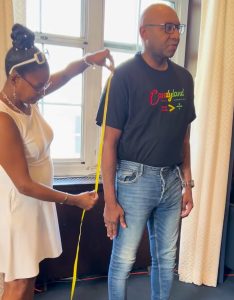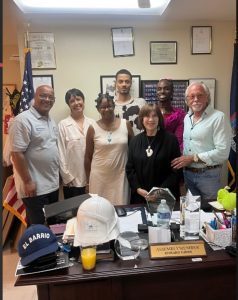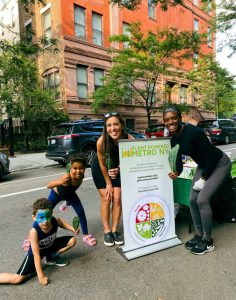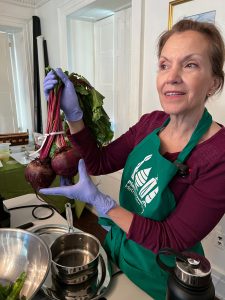Brooklyn–Queens Rail Link Advances With MTA Design Approval
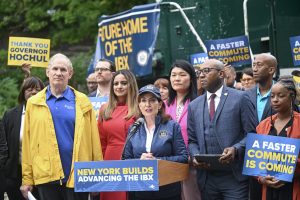
Governor Kathy Hochul makes an IBX transportation announcement in Brooklyn. (Susan Watts/Office of Governor Kathy Hochul)
MTA Moves Ahead With Interborough Express Design
MOHAMED FARGHALY
mfarghaly@queensledger.com
A long-discussed rail link between Brooklyn and Queens took a major step forward this summer after the Metropolitan Transportation Authority approved a $166 million design contract for the Interborough Express.
The project, known as the IBX, would convert a little-used freight line into a 14-mile light rail corridor stretching from Bay Ridge, Brooklyn, to Jackson Heights, Queens. The line would bypass Manhattan entirely, cutting end-to-end travel times to under 40 minutes and connecting riders to as many as 17 subway lines and the Long Island Rail Road.
Gov. Kathy Hochul first directed the MTA to study the project in 2022. After reviewing alternatives, the agency selected light rail in 2023 as the preferred mode of transit. An environmental consultant was retained later that year, with a series of public engagement events held through 2024 and 2025.
“Building the Interborough Express will transform New York, connecting communities like never before, shortening commutes and unleashing the full potential of Brooklyn and Queens,” Hochul said.
The MTA board voted July 30 to retain Jacobs and HDR as the lead design firms. Construction is expected to cost about $5.5 billion and will be funded through the authority’s $68.4 billion 2025–2029 capital plan.

The Interborough Express corridor is already home to nearly 900,000 residents and more than 260,000 workers within a half-mile of the line. Forecasts from the New York Metropolitan Transportation Council project that the area will add at least 41,000 residents and 15,000 jobs by 2045, growth that transit planners say underscores the need for improved service. Nearly three-quarters of the population along the route are people of color, half of households lack access to a car, and 19% live below the poverty line — factors the MTA has pointed to in framing the IBX as an equity-driven project.
The proposed light rail would connect communities that are both economically and culturally diverse, stretching through neighborhoods such as Sunset Park, Borough Park, Kensington, Brownsville, East New York, Ridgewood, Maspeth and Elmhurst. With 19 planned stations, the IBX would link riders to as many as 17 subway lines, 51 bus routes and the Long Island Rail Road. Officials say the project could dramatically cut commute times for the majority of corridor residents who work within their own borough, offering a direct Brooklyn-to-Queens option that avoids Manhattan.
“The selection of the design team for the Interborough Express is a major milestone and an exciting step forward for New York. This transformative project will modernize the MTA and better connect millions of New Yorkers across the boroughs, especially my home borough of Queens. I’m grateful to Governor Hochul for her leadership and commitment to expanding efficient, accessible transit options for all,” Assemblymember Jessica González-Rojas said.


Courtesy MTA
Unlike other major transit expansion projects, the IBX would run largely within an existing freight corridor — 11 miles owned by the MTA’s Long Island Rail Road and three miles owned by CSX — minimizing the need for new land acquisition. Two new passenger tracks would be added alongside freight operations, with upgraded infrastructure intended to reduce noise and emissions. The MTA has stressed that passenger service will be designed to coexist with freight traffic, while preserving the corridor’s role in regional goods movement.
“New Yorkers have long desired better ways to get between Queens and Brooklyn and the IBX offers an innovative solution to this age-old problem. Looking forward to the design team’s plans and progress so we can at long last get this important project rolling and give the outer boroughs faster, more reliable public transportation,” State Senator John Liu said.
Supporters say the Interborough Express could help knit together Brooklyn and Queens in ways the city’s existing transit network does not. With few direct rail options between the two boroughs, many commuters are forced to travel through Manhattan, adding time and strain to daily trips. By creating a faster, more reliable link, the IBX is expected to expand access to jobs, schools, and services, while also fostering stronger economic and cultural ties between neighborhoods that have long been difficult to reach from one another.
But even as the Interborough Express moves ahead, some Queens residents and homeowners have raised concerns about the project’s impact. Critics worry that neighborhoods along the corridor — many of them low- and middle-income — could be overburdened by increased foot traffic, noise, and construction disruptions. Others fear the new line could accelerate gentrification, driving up housing costs and putting pressure on longtime residents. Homeowners near the right-of-way have also voiced unease about property values and the possibility of expanded rail operations changing the character of their blocks.
The MTA has emphasized public engagement throughout the planning phase, holding open houses and pop-up events to explain the environmental review process and gather feedback from residents. Officials say reusing existing freight rail infrastructure will allow the IBX to be built more efficiently while preserving the Bay Ridge Branch’s use as a freight line, limiting the need for new land acquisition. Agency planners have also argued that the project’s design will deliver the best service at the best value for riders, while offering a faster commute and new transit options for neighborhoods long underserved by the subway system.

Screenshot



